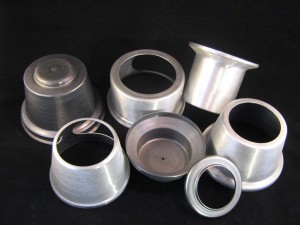Metal spinning is an old process that fundamentally has not changed all that much since it was introduced into the manufacturing process.
The process uses a tool that becomes the inside form of your part. This tool looks like the part that is being made. In the spinning process, the metal blank is pressed against the forming tool and then the tool and the blank rotate. Once the part is spinning, a series of roller balls are used to apply pressure to the metal blank causing it to move and conform to the inner tool shape.
Generally there are multiple roller balls used – all with different wheel diameters and shapes. This allows the part to have different radiuses applied and different surface finishes applied. The spinning process is an excellent process with relatively low tooling cost that allows for low and medium production volumes.
There are many metals that can be spun including – but not limited to – aluminum, steel, stainless steel, copper, brass, tin and lead. Some metals will harden through this process and require spin forming in multiple steps. During this process, the hardening is removed from the metal to allow it to flow properly. However, parts may also be hardened after spin forming to increase the strength of the part for your specific application.
 Product types
Product types
- Cones
- Dishes
- Air Inlets
- Cylinders
- Rings
- Flanged Parts
- Tank Ends
- Funnels
- Aerospace Parts
- Lighting
- Medical
- Industrial
If you have any questions or need more information about metal spinning, please do not hesitate to contact us.

